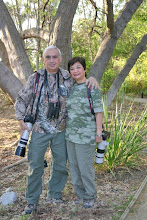Nevertheless, my wife and I still woke up early Saturday morning. I guess our bodies were already accustomed to the routine of going birding this day of the week - which, naturally, necessitates an early rising. As we yawned and stretched we noticed something bizarre - it was not raining! Not only that the skies were gloriously clear! We looked at each other silently asking where we can go birding. "Antipolo!" simultaneously came from our mouths. We have gotten so used to each other that our thinking had always been in synch.
In a short span of time we were on the road to our destination. Palos Verdes Subdivision never disappointed us when it came to birding. We hoped that such good fortune still holds as we entered the gates. Thirty minutes later and we had not seen anything interesting except for a feisty Philippine Pied Fantail. I was beginning to feel the pangs of the misfortunes we experienced for the past several months - where the birds we encountered were as scarce as an honest politician.
As we approached a swath of tall grass, we noticed the brown dots among the stalks. A flock of about 20 Scaly-breasted Munias were feeding on the abundant seeds. Easily this species became our bird of the day. At several places these little brown jobs were busy enjoying their morning repast.
The Munias were the spark, as it were, for after seeing them, the birds suddenly appeared. While Cynthia was still enjoying these friendly birds, I shifted my attention to the White-breasted Wood Swallows. More often than not, these flyers prefer electric wires are their perch of choice. Here, however, the Wood Swallows prefer the tree branches.
There were still traces of bad luck, unfortunately, exemplified too painfully by two birds of the Rallidae family. Both the Barred Rail and the Plain Bush Hen were walking side by side on the road ahead of us. However, as soon as we got our gear, in a seemingly coordinated effort, both quickly disappeared in the bushes, denying us of any good photos.
Other than that, we were blessed with the sightings of more birds. The usually energetic Golden-bellied Gerygones and occupiers of the upper portions of tall trees somehow went a little lower and posed long enough for us to get some good shots.
Another interesting observation we had was when an adult male Olive-backed Sunbird showed up. I could be wrong but there seemed to be a little orange tinge on its breast. Of course only the aurorae subspecies which is endemic to Palawan has this kind of coloration. Just an optical illusion, I guess.
From eight in the morning onward it had been a case of name the bird and it will appear. As soon as we got into this subdivision one of the very first birds we looked for was the locally common Long-tailed Shrike but we never saw any from the places they usually hang out. So when I thought out loud as to where these birds were, it didn't take long before two, yes two, of them flew to the ground in front of us. But..I only got a photo of one.
Another species that we wondered why haven't seen one yet was the Collared Kingfisher. We were driving by the "pond" when I caught a glimpse of something blue-green make a dive. "Kingfisher!" I exclaimed. I rounded the corner hoping to see where that kingfisher landed. There on a branch, bashing an ill-fated frog, was our sought after bird.
Then it was my wife's turn to wonder about the normally skittish Spotted Doves. You guessed it - one of them walked insouciantly not far from where we were.
Finally, the last bird we hoped to find but did not see right away was the Grey Wagtail. We headed towards the place where we had seen this migrant the past couple of years. It wasn't there. On the way out and there it was - hunting for insects near the flowing water next to the curb.
We had two more birds on our list and the place where we knew we can surely find them was at the Holy Garden Memorial Park. Of course, we were right. Both the Paddyfield Pipit and the Pied Bush Chat were there.
 |
| Paddyfield Pipit |
 |
| Pied Bush Chat - female |











No comments:
Post a Comment